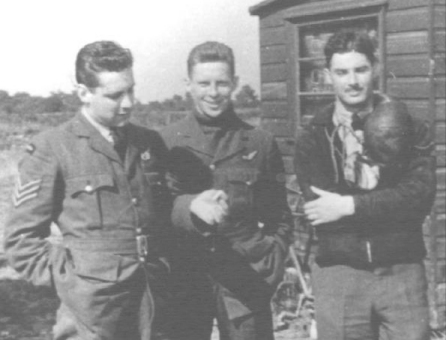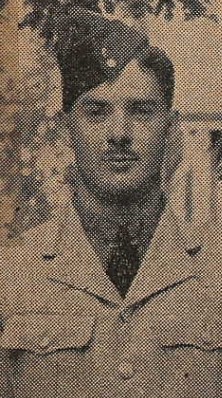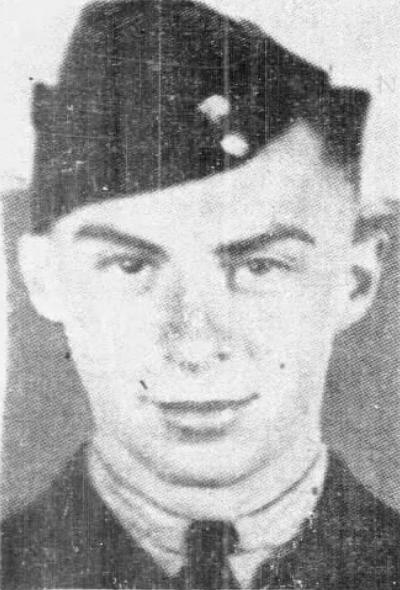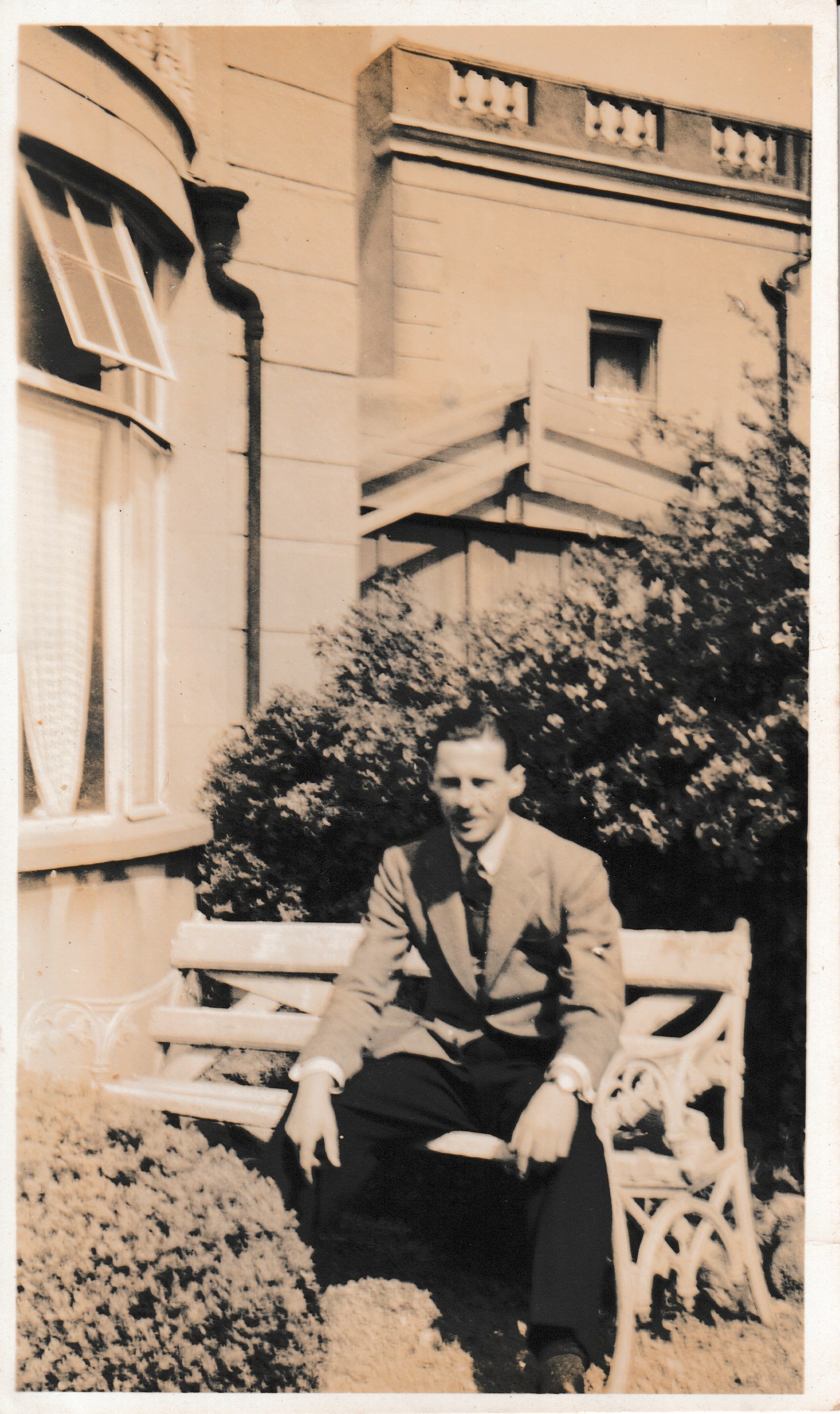Bristol Blenheim, near Calf Island, Cork, October, 1941
The coastal town of Schull in the southern extremity of County
Cork were the witnesses to the sad results of war on an October
day in 1941.
The Southern Star newspaper on November 3rd, 1984 published the
following account of the situation that unfolded on that
Thursday morning. It is likely written based on the Irish
Army's G2/X/0893 file on the events and from eye witness
accounts.
A local fisherman, Jimmy O'Reilly, was
walking down Pier Road that day. He had just turned off
towards the pier, when quite suddenly he saw the aircraft.
It was lying in the water, with its tail rising forlornly
into the air, as it slowly sank to the bottom.
O'Reilly hurried down to the pier where he met another local
man, Joe Newman and Garda Sergt. O'Brien. Together they
boarded Newman's boat with a couple of other men, and put
out to help the stricken air crew.
It was a wild day with strong easterly winds and the
aircraft had drifted westwards to the south of Long Island.
A row boat from the island however, picked up the crew from
the aircraft before Jimmy O'Reilly and the others could
reach them. But as the rowboat tried to come alongside the
motorboat, it became obvious that they were unable to row
against the wind. Newman was therefore forced to bring
his boat around Long Island before the airmen could be taken
on board.
The boat now headed back to Schull, where a large crowd
had assembled on the pier. At this however, a further
problem arose.
One of the Canadians, Sgt. Woodman, had suffered severe
internal injuries in addition to a broken leg and there was
difficulty in getting him ashore. He was covered in
blood and everyone around was both shocked and apprehensive
of causing him further pain. At length an onlooker,
Michael O'Regan, overcome by compassion, jumped into the
boat and helped Sgt. O'Brien and the others bring him into
the pier, where he was treated by Dr. Shipsey. Soon
afterwards he was rushed to Gould's Hill military hospital
where he died the following day at 10.35 p.m. He was aged
23.
In the meantime, a military detachment
under Sgt. Major McLoughlin had arrived from Bantry and
taken the remaining two airmen into custody. While
they were waiting for transport to take them away, the two
airmen were made as comfortable as possible.
Finally, at 4.30 p.m. they were taken to Bantry, before
being transferred to the Curragh military camp in Co.
Kildare. Arriving at approximately 11.30 p.m. they were
officially interned.
Gouldshill Hospital, in the town of Mallow was about two hours
drive away, perhaps longer given the roads and vehicles of the
time.
In a flurry of telegrams on 24th October, 236 Squadron, when it
found that the aircraft was missing, sent telegrams that the
aircraft, variously noted as Y5728 or V5728 was last seen north
east of the Fastnet Rock heading for Southern Ireland. The
aircraft had radioed at 1120 HRS that it had engine trouble and
was heading for base. At the point it had been ascertained that
they crew had made it to land in Ireland and were assumed to be
interned.
By the early morning hours of October 25th, the news of Sgt
Woodman's death had been received by the Air Ministry and
messages sent to Canada to inform his father. The British
Attache in Dublin that day began arranging with local
authorities to have him buried and it was planned provisionally
then that he would be buried on the afternoon of October 28th.
Newspapers across
Canada carried a news article on or after the 29th of
October that Douglas had been buried in Mallow on the
Monday, 27th October.
Canadian Airman Is Buried in Eire
MALLOW, Eire, Oct. 29 .- Accorded full military honors, Sgt.
Douglas Albert Woodman, Royal Canadian Air Force, was buried
here Monday. He was fatally injured in a crash on the west
coast of County Cork.
A representative of Eire's chief of staff and other officers
marched with representatives of the Canadian Government
behind the coffin draped in the Union Jack. Shops were
closed while the cortege passed through the streets.
 The three crew members were members of the Royal
Canadian Air Force and had arrived in the United Kingdom at
various times in 1941. Following their training in Canada,
they undertook operational training together as a crew at 2
Operational Training Unit based at . This allowed them to
convert to the Blenheim IV fighter and to operate as a team of
Pilot, navigator and wirelesss operator/Air gunner.
The three crew members were members of the Royal
Canadian Air Force and had arrived in the United Kingdom at
various times in 1941. Following their training in Canada,
they undertook operational training together as a crew at 2
Operational Training Unit based at . This allowed them to
convert to the Blenheim IV fighter and to operate as a team of
Pilot, navigator and wirelesss operator/Air gunner.
The photo shown here is of all three men, from left to right,
Left to Right: Woodman (Nav); Brady (Wop/AG), Webster (pilot).
They participated in their first operation patrol on the 14th
of September. The tasking was to provide air cover for a
convoy codenamed Camel, but owing to the weather produced zero
visibility, they never found the convoy. The same outcome
was experienced by them on the following day, September
15th. Another crew later that day were forced to abandon
their Blenheim over the same convoy due to bad weather
conditions. No more operational missions were flown that
month or at least recorded in the ORB.
16th October was their first operational sortie of the month,
when they were forced to return to Chivenor due to failure of
the fuel feed from their port tanks. The following day
their mission saw them escort a ship which had to direct to
rescue a man in a dingy next to a partially submerged
aircraft. Their next mission, was the 21st of October,
where they provided escort to a Sunderland flying boat. It
is interesting to note that their take off was delayed when
aircraft J, went unservicable and they had to transfer to
another Blenheim coded N ()5895. Aircraft J was likely the
ill fated V5728 that failed them tradgically two days later
although the letter could have been applied to a replacement
aircraft during that time. Another ship escort was flown
on the 22nd of October without incident.
The 23rd of October saw them take off at 09:10 hours to provide
escort to convoy SL89. They didn't manage to meet to the
convoy as they radioed at 10:51 hrs that they were returning to
base.
The 236 Squadron Operations Record Book recorded for the day:
Five sorties, two aircraft each, on A/A escort to ocean
convoy. Four being met, one not met. Aircraft "J" first
sortie of the day landing in Eire due to engine
trouble. Aircrew being interned. Squadron
notified that Sgt.Woodland (Obs) had passed away in
Dublin Hospital. Aircraft X and D the 4th sortie of the day,
both aircraft after being airborne for 7 hrs 5 mins landed
at St. Athans =Colerne due to petrol shortage.
Aircraft X port engine cutting out while taxying from flare
path owing to petrol giving out. Sgt.McCaffry Pilot and
Sgt.Lamerton in aircraft V, the last sortie of the day on
returning, overshot the drome and were killed
instantly. One sortie with one aircraft escorted
convoy without incident, Ianding at Chivenor due to W/T
failure.
The three crew members are discussed below.
 Piloting
the aircraft was Sgt Paul Osbourne WEBSTER
R/58435. Paul was the son of Ethel and William Webster and
was born to the couple at the start of May 1920 in Vancouver.
Piloting
the aircraft was Sgt Paul Osbourne WEBSTER
R/58435. Paul was the son of Ethel and William Webster and
was born to the couple at the start of May 1920 in Vancouver.
He gratuated from 3 SFTS at Calgary on Friday, the 2nd of May
1941. Two months later, he had arrived in England with a
large shipment of new air crew and was quoted in newspapers all
over Canada as saying: "This
business of day and night trans-channel raids by the R.A.F.
has pepped up the fellows a lot and we hope to get into some
soon," said Sgt .- Pilot P. O. Webster, of Vancouver, a
night fighter possibility.
Sgt Webster escaped from internment in April 1942. He had
been part of the attempted ladder escape on 9 Feb 1942, but was
captured within the compound area. A few weeks later, in
the 15th of April 1942, in a stroke of luck, while he was out in
Naas town on parole from the Curragh Internment Camp, his parole
form was accidentally signed by a camp guard when another
internee was returning to the camp. Upon discovering this,
the cancelled form was taken out of the camp by Brady and
delivered to Webster who took off for northern Ireland.
This was the first escape by an internee since June 1941.
Paul's elation was short lived however. He returned to
his former unit, 236 Squadron, on the 19th of May where he
converted to the Beaufighter aircraft. His first operational
mission was on 19th July, from the detachment at Oulton.
He flew again on the following day, but failed to return from a
recon mission on July 24, 1942. He was lost along with his
navigator/gunner Sgt G R Lewis of the RAF when their Beaufighter
X8088 failed to return from an armed recce mission against enemy
shipping routes between Texel and Borkum. Four aircraft
had departed on the mission and two returned owing to weather
conditions, with a third suffering engines problems forcing it
to return after an hour.
As his remains were never recovered, his name is entered on the
Runnymede Memorial in the UK. Vancouver newspapers
reported on his loss as eerly as July 29th.
His name then appeared in papers across Canada stating he was part of the ladder escape attempt, the article being published. country wide around Jun 29th. Then again, after his death, the same list of names were republished by many newspapers just after the 17th of August escape by three other internees, days after his missing in action status was published.
 Sgt
Douglas Albert WOODMAN R/60047 was the aircraft observer,
or navigator. Douglas was born in St. Catherines, Ontario
in July 1918 to Hazel and Ezra Woodman. The family grew up
in that town where sadly his mother passed away in 1938.
Sgt
Douglas Albert WOODMAN R/60047 was the aircraft observer,
or navigator. Douglas was born in St. Catherines, Ontario
in July 1918 to Hazel and Ezra Woodman. The family grew up
in that town where sadly his mother passed away in 1938.
Douglas served as a cadet in the St Catherines Collegiate Cadet
Corps and Queens university officer Training Course during
1931-32 and 1937-39 within the engineering and signals
trades. He had studied in Queens University durign
1937-1939 but his R.C.A.F. application indicates his studies
were unsuccessful during his second year. During his
summers he had worked in various underground mining
activities. His second successful Air Force
application in April 1940 was made in Alberta where he was
living at the time.
Douglas passed through 3 EFTS starting in June 1940, then on to
1 AOS in November of that year. This does suggest he was
first sent for pilot training, which not all candidates were
successful at but many passed on to navigator or air crew
trades. he then spent a period at 1 B&GS before
completing training at 1 ANS. Woodman had arrived in the
UK in June 1941. He was posted to 2 OTU and from there to
236 Squadron on the 1st of September 1941.
Sergeant Douglas Albert Woodman, aged
23, son of Mr. E. A.Woodman, 31 Duke street, and the late
Mrs. Woodman, who was attached to the Royal Air Force as a
navigator, died in Mallow Hospital, County of Cork, Eire at
10:30 p.m., Friday, October 24, his father was informed by
cable Sunday. The first cable, received Saturday, stated
that Sergeant Woodman had been interned as the result of air
operations, and while details are lacking, as yet, it is
presumed that the St. Catharines youth was on a patrol and
the plane crashed.
News of the tragedy was received with deep regret in
this area where Sergeant Woodman and his family are well and
favor-
ably known. He is survived by his father and a younger
brother, Oswald Ross Woodman.
The late Sergeant Woodman was born in St. Catharines
July 2, 1918. He was educated in the public schools and
Collegiate Institute, and was a science student at Queen's
University. He enlisted in the R.C.A.F. in May, 1940, and
was trained at Manning Pool, Toronto, Malton, Jarvis, and
London, completing his navigator's course at Rivers, Man. He
went overseas May 11, 1941, and was transferred from the
R.C.A.F. to the R.A.F.
The Standard newspaper published an article about Douglas again
in February 1946 on the occasion of the receipt by his father of
his wings and certificate. The paper told again of his
being on a convoy patrol and coming down off the coast of
Ireland. The paper did mistakenly assume he had been shot
down in the course of his duty. He had been a carrier boy
for them for seven years.
Fast forward to 31st March 1986 and the Standard again was writing about Douglas, this time following receipt by his late brother Oswald of letters from Ireland informing him of details of a memorial planned to take place in July that yer in at Bantry House.
Douglas's name is recorded on a plaque on a wall at Bantry
House, Bantry, Co. Cork next to one for the crew of Whitley
Z9388. They were unveiled at a ceremony on the 19th of
July 1986 by the Warplane Research Group of Ireland.
Douglas's brother Oswald passed away in but kindly left some of
his brothers memories with a family friend who shared them.
 Sgt Charles
Stewart BRADY R/69652 took up the rear of the aircraft and
was the wireless operator / air gunner.
Sgt Charles
Stewart BRADY R/69652 took up the rear of the aircraft and
was the wireless operator / air gunner.
Chuck, as he was known to other internees was the son of Mildred
and Charles Stewart Brady and had been born to them on the 17th
of March 1920 in Toronto. Charles father passed away in
October of 1936 in that city. Chuck's paternal
grandparents, Michael Brady and Mary Begg had been born in
Ireland.
His mother Mildred, was a head cook at the Active Service
Canteen in Toronto during the war.
The Toronto Star throughout the war, published news updates on
Chuck, especially through his being interned.
On the 4th of November they published the following news:
Another Glad Mother
Mrs. Isaac Ilsley, Glencairn Ave., Toronto, was
beaming as she announced she had just received a cable
from her son, who was reported missing last week.
Sgt. Charles S. Brady, R.C.A.F., is interned
in Eire, his cable said. "He'll be sorry to miss the
rest of the fight," remarked his mother.
Last week she heard from Miss Barbara Hancock
of Toronto that her fiance, Douglas Woodman of St.
Catharines, observer on Sgt. Brady's plane, had died
of injuries in a forced landing. Later Mrs. Ilsley
received a cable saying her son was believed
interned in Eire.
At once she telephoned the Canadian chief
censor, who found what camp Sgt. Brady was in. She
then cabled him. He replied, "Safe and O.K.
Send £15 ($75) Love, Charles."
What Mrs. Ilsley heard from Miss Hancock was
that the engine of her son's plane had failed over
the Atlantic and that it barely reached land.
He was wireless operator and air gunner. He left
Canada in April, soon after his 21st birthday. He attended
Lawrence Park collegiate.
His father, the late C. S. Brady, was a
lieutenant in the last war. Last letter his mother
had said he believed he had helped escort the ship
which brought his cigarettes.
XXX.
Toronto Star in 23rd January 1943 carried the following
newspaper article gleaned from letters sent to his mother.
Only in the romantic land of Eire could
such a situation be found where inmates of an internment
camp are free to go out anywhere in a 10-mile radius every
day, honor bound not to attempt escape, but when in camp,
may with impunity seek to make a break for freedom.
In Camp Curragh, Kildare, Eire, there is a small group
of British and Canadian airmen. Forced down in that neutral
country, or in the sea about it, they have been interned for
the duration. Among them is Pilot Officer Charles S. Brady,
23, R.C.A.F., whose mother Is Mrs. Mildred Ilsley, Glencairn
Ave.
Last August Pilot Officer Brady made his third attempt
to escape. He and five others built a ladder. At the
last barrier three airmen successfully scaled it and fled to
safety, but Pilot Officer Brady and two others were caught
when the prison-made ladder broke. "After all. I did not
enlist to have a good time. I want action." he wrote not
long ago.
Pilot Officer Brady's plane crashed
into the sea not far from the rocky coast of Eire. His
observer was badly injured and died the next day. He and his
pilot. Paul Webster, were un-harmed. Webster later escaped
from camp, went back into action and was killed last year.
Live in Huts
"We get our room and board here, but that is
all," the Toronto boy wrote. "We live in huts and life is
rather monotonous. We have to find our own amusement. We are
allowed to go out every day, giving our word not to attempt
to escape.
Once a month we are allowed to go to Dublin with an
escort."
He said that all the boys of the camp have bicycles and
cycle every day. They do no work, although sometimes they
volunteer to help the farmers with farm work. They read the
newspapers and listen to all the news over their own radio.
Charles has a dog of whom he is quite fond.
Once a wealthy landowner in the
adjacent country invited the boys to his home for dinner and
entertained them royally. Later, when they heard he needed
help with the harvest, they all volunteered to aid him.
"The Canadian high commissioner to Eire. John D. Kearney,
invited us to his home in Dublin last Christmas. We had a
grand time. Nothing seemed too good for us. They
made us right at home. For a Christmas gift they gave us a
radio and a ping-pong table," the Toronto flier said.
Pilot Officer Brady attended Lawrence Park collegiate, and
enlisted as a wireless air gunner in the R.C.A.F. He went
overseas in March. 1940. He received his commission while in
camp.
The following photo of Chuck was taken in the family home of
his aunt Emily in Dublin, visiting on parole.

The Toronto Star again on the 30th of October 1943 reported on
Charles but this time that his fifth 'escape attempt' had been
successful and he was safe in England. Upon his release
from internment, he was interviewed and filed an escape and
Evasion reports which deals with his two years of internment
very briefly.
I took off from CAREW CHERITON, South Wales, on 23 Oct 41 in a Blenheim fighter, and came down the same day in the sea off SCHULL, CO. CORK. I was sent for internment to the CURRAGH CAMP.
Following his release from internment, Chuck returned to flying
duties and went on to serve with Bomber Command as a Wireless
Operator/Air Gunner with 434 Squadron between July and
December 1944. During this time he earned himself a
Distinguished Fying Cross with the following citation published
in the London Gazette.
Flight Lieutenant Brady has
successfully completed a second tour of operations as
wireless operator. He has at all times displayed a
fine offensive spirit and devotion to duty of a very high
order. On one occasion during an attack on Bochum [9
October 1944], Flight Lieutenant Brady's skilful and
accurate work enabled the crew to successfully evade
through fighter attacks under harassing circumstances.
He has been recently employed as signals leader in the
squadron and as such has carried out his task in a highly
efficient manner. His efficiency both in the air and
on the ground has contributed greatly to the success of the
unit.
He married in London in May 1944, to Olive Clive.
The Toronto Star again, on 20 July 1986 carried a half page
spread of two articles relating to the demise of Blenheim V5728.
A letter had been published sometime before that from members
of the Warplane Research Group of Ireland seeking information
about the crew of a bomber that had crashed off Ireland, one of
whom, Sgt Woodman was buried in Mallow.
Compiled by Dennis Burke, 2025. Sources: Irish Military
Archives File: G2/X/0893, Newspapers mentioned in text from
Newspapers.com, Records sourced via ancestry.com and
archives.gov.
